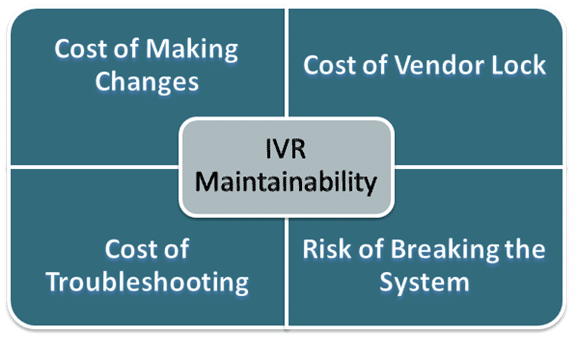IVR Maintainability
IVR Maintainability reflects your ability to change and configure the automated voice menus that your customers navigate to accomplish their goal when contacting you. It is the first point of our VoiceVision 14 Point Diagnostic which we will discuss in detail.
IVR Maintainability is what we consider a “cost driver” for operating your enterprise’s communication systems. Poor IVR Maintainability leads to changes costing more than they should, and perhaps even a stagnant, paralyzed interface that drives away customers. Let’s take a look about why that is.

Cost of Making Changes
IVRs, Auto-attendants, and PBXs come in varied arrays of software and hardware. Each brand and vendor has its own method for configuring and programming voice menus. In some cases, there may even be business logic built in (account lookups, time-of-day calcualtions, etc) The simple question to ask is whether the interface of your current system is in line with your business needs as the administrator. If changes were free and immediate, how often would be making changes to the call flows of your automated voice menus? Compare that to how often you make changes in reality. What is it that costs too much in terms of time or fees that accounts for the difference?
Cost of Vendor Lock
It’s common wisdom that vendors in most industries make their living on service and maintenance fees as opposed to the margin on the initial sale. The same can be said for IT and telecom vendors. When it comes to IVR systems, there are few issues to look out for that can tie your hands if not addressed. The first, and easiest, item to address is documentation. Do both you and your vendor have an accurate representation of what the system is supposed to do? If not, you put yourself at being held hostage in a costly support agreement, with a vendor who knows he’s the only one who can make changes. The second item is the standardization of the development platform. Is your system built on a common, open standard like VoiceXML, or is it pieced together on some proprietary, vendor-specific tool? The latter may be cheaper in the short term, but a move to an open standard can allow for portability of your applications across platforms, not just support vendors.
Risk Of Breaking the System
Documentation is key to confidence, and in this case we’re talking about documentation of business processes in addition to technical implementation. If you’re operating without useful documentation that’s actually consumed by those in your organization, then you’re at risk for costly rework or panicked scrambling when a change goes horribly wrong. The impact of technical changes made to systems can only be properly assessed when the complete business uses and stakeholders are understood. The technical feasibility of business changes, and therefore budget, of requested application changes, can only be assessed when the capabilities of your system are captured and circulated.
Cost of Troubleshooting
The last major benefit of operating a maintainable system (or cost of operating a fragile one) is the time and effort it takes to investigate incidents, complaints, or the occasional bug. A well-designed, standards-based system should allow for technicians to have a window into what happened on any given interaction, whether through call data, logs, or even just clear insight into why the system logic behaves like it does. Proprietary systems may operate efficiently, and both users and administrators are satisfied when the system works properly. However, when something inevitably goes wrong, how will you know your system was built within the parameters of the platform and not hacked together to meet your specific requirements?
Maintenance is one cost of operating a communications system. We’ll look at others such as telecommunications usage and agent utilization. The main tenet of VoiceVision, though, is that cost must be balanced with managing the customer experience and business risk profile.
Find out more about the VoiceVision 14 Point Diagnostic Evaluation process by reading our white paper – Assessing Your Telephony Universe.
